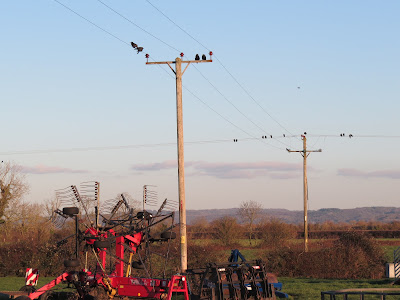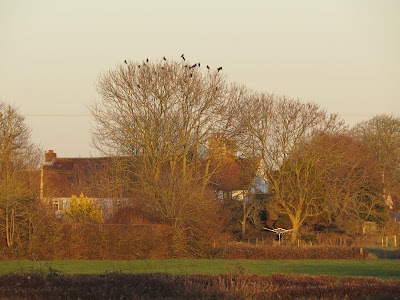Way back in 1995 when I found myself living in East Brent in Somerset, my then landlady Mrs Jean Williams, visited what was then the newest Royal Horticultural Society garden Rosemoor in Devon. I remember her returning and knowing of my interest in gardening said I should enjoy it suggesting maybe we could go together regularly and watch the garden, which opened to the public in 1990, develop over time. Sadly none of that suggestion happened and it took me nearly three decades to finally make the hour and a half drive to north Devon and finally visit. It has also taken over a week to write up this visit. A pattern of delay is emerging.

How had it taken me so long to visit? I'm not sure, life just gets in the way, but over the Christmas period despite the weather being so dire the effort was made. To be fair the weather wasn't awful, just perpetually wet, very dark during the day and basically a smorgasbord of grey enveloped the landscape. Each time I ventured outside I seemed to return like a wet rag. Two days before Christmas our walk around Cheddar Reservoir was, well quite wet. Christmas Day saw Julie and I down on the Somerset Levels as has become a little of a Festive tradition now, and we were soaked through. On Boxing Day we simply abandoned another walk before it began as the rain started to fall heavily and never stopped. However on December 29th the forecast for Devon was for heavy blustery rain blowing through quickly overnight followed by sunshine and showers during the day, before more rain would arrive before midnight. A dry window of opportunity then, and I'm so pleased it allowed the visit.

Back in 1995 when Mrs Williams visited RHS Rosemoor the garden was still very much in an on-plan development stage. RHS Rosemoor is still developing, despite the garden and adjacent pastureland being gifted to the Society in 1988 by Lady Anne Berry (1919–2019). This mini estate had been her family home having been bought in 1931 by her father Sir Robert Horace Walpole as a salmon fishing lodge. Its then 8 acres of gardens were of standard Victorian inspiration, lawns, formal flower beds and it was not until her mother installed the stone garden just before World War 2 that any semblance of garden design began to take place. Lady Anne herself is credited as having caught the garden bug in the late 1950's having met the well respected ornithologist and plant collector Collingwood Ingram. He received a moniker 'cherry Ingram' for his knowledge of Japanese cherry trees, he also knew quite a bit about Asian bird species. I digress.

It is 87 miles from home to the garden just outside Great Torrington in north Devon, and as had been expected the rain never stopped on the entire journey, until that is we arrived and the sun came out. Perfect. A sun kissed visit was in prospect to explore the garden for the very first time. We were not disappointed. Julie is a professional horticulturalist so after the obligatory cup of tea and a bacon butty (for research purposes) we split up for a while to explore the garden in our own ways. Of note Julie said when we reconvened was the exceptional labelling of every plant in the garden, a gigantean task given the RHS have expanded the garden to cover 65 acres today. I studied horticulture with the RHS myself thirty years ago as an amateur interest, today however I simply enjoyed the views and took the photographs accompanying this record.

Even in the depths of winter this garden is beautiful with an awful lot to take in, much too much for one visit if truth be told. The long walk above seamlessly splits the formal garden from the visitor centre. There is something magical in a tightly clipped winter structure I feel. Yet buried amongst the formality nuggets of informality, such as the catkins emerging on to the chaotic structure of this corkscrew hazel.
I've lost so much knowledge of plants over the last few years as I now rely on Julie to identify everything for me while we're out and the home garden is her domain. But despite diminishing memory my love for gardens has not weakened and I am increasingly drawn to the feel and atmosphere of a garden, such as the Winter Garden below one of the many rooms within the formal garden, rather than the individual plants therein.
The climate in this part of Devon is a moist oceanic influenced one, winters are generally mild with summers warm rather than hot, and not as dry as across in eastern England. Perfect conditions to grow some of the more tender species, that Atlantic derived weather influences air quality too. Everywhere there is evidence of how unpolluted the air is with lichen and mosses covering every structure, even the marker signs.
New structures are still being built around the garden, such as the Cob Shelter which provided the perfect frame for a view back towards the Learning Centre which though it was closed on my visit looked fascinating in its own wooden design. Glorious too to see blue skies overhead adding to the bright winter atmosphere.

The rain almost kept off during our visit, a brief squall when we were in the Foliage and Plantsman's Garden didn't dampen our spirits. Even as the light levels dropped the clever planting here flashed colour into the rain.
That squall soon passed and allowed more time to be spent in what for me was the highlight of the formal areas, the Herb, Potager and Cottage Garden. I loved the centrepiece of a simple round pond with child in repose from which the four main quadrants emerged. The winter structure made this garden a delight to visit in December, yet what this garden would look like in spring or summer is intriguing. I feel another visit is a must this year not least as being an RHS member entry is of course free.
Local Devonian craftsmanship is evident everywhere including this easily overlooked Devon Hedge, this one a drystone wall with the traditional chevron design with herb and potager planting on top. A nice touch indeed.
The Cottage garden has a lovely permanent structure, which on the map is shown as simply 'shelter'. It is so much more. I sat there for a while just enjoying the peace and quiet, on this day we visited there were only a handful of other visitors. In the near silence I could hear birdsong easily, great and blue tits, a robin and somewhere behind me a wren. A gloriously restorative moment here.
A sculpture exhibition was taking place, with this cat on a ball taking my eye, albeit with an eyewatering price tag. Not this year I fear.
It may be midwinter but the signs of spring were pushing through - by the Wisteria Lodge drifts of snowdrops were already in flower and these daffodil 'Rijnveld's Early Sensation' bursting through the grass were a welcome site.
Outside the formal garden the Lake is apparently regularly frequented by otters so the sign said. Not today sadly but the blue skies reflected well the birch planting on the opposite bank, flanked by various cornus species looking as if they were on fire in the weak sunhine.
Further into the less formal areas of the garden, this display of colourful squash in the 'shelter' of the Fruit and Vegetable garden also brought a fiery brightness to the well organised and frankly stunning working part of Rosemoor. I was impressed, not least when I discovered later there are only eight gardeners, plus volunteers.
Though there may be a lot of hard work to keep this garden looking so stunning, there is a fun element too with their recreation of Mr McGregor's garden from Peter Rabbit to entertain the younger visitors, such as myself.
The second tranche of rain during our visit arrived quickly and was beginning to settle in for a longer spell. We'd been walking for two hours and not really explored more than half of the garden. Chatting to a couple and their friend as we all sheltered from the deluge they let it be known that they come regularly and suggested when the rain eased we head to Upper Woodland Walk to look back onto the whole of Rosemoor from the highest point. Watching the rain fall quite heavily now Julie and I made the decision to abandon any more exploration for the day and plan to complete that walk on our next visit. Which I hope won't be in three decades time, late spring this year, maybe?
























































